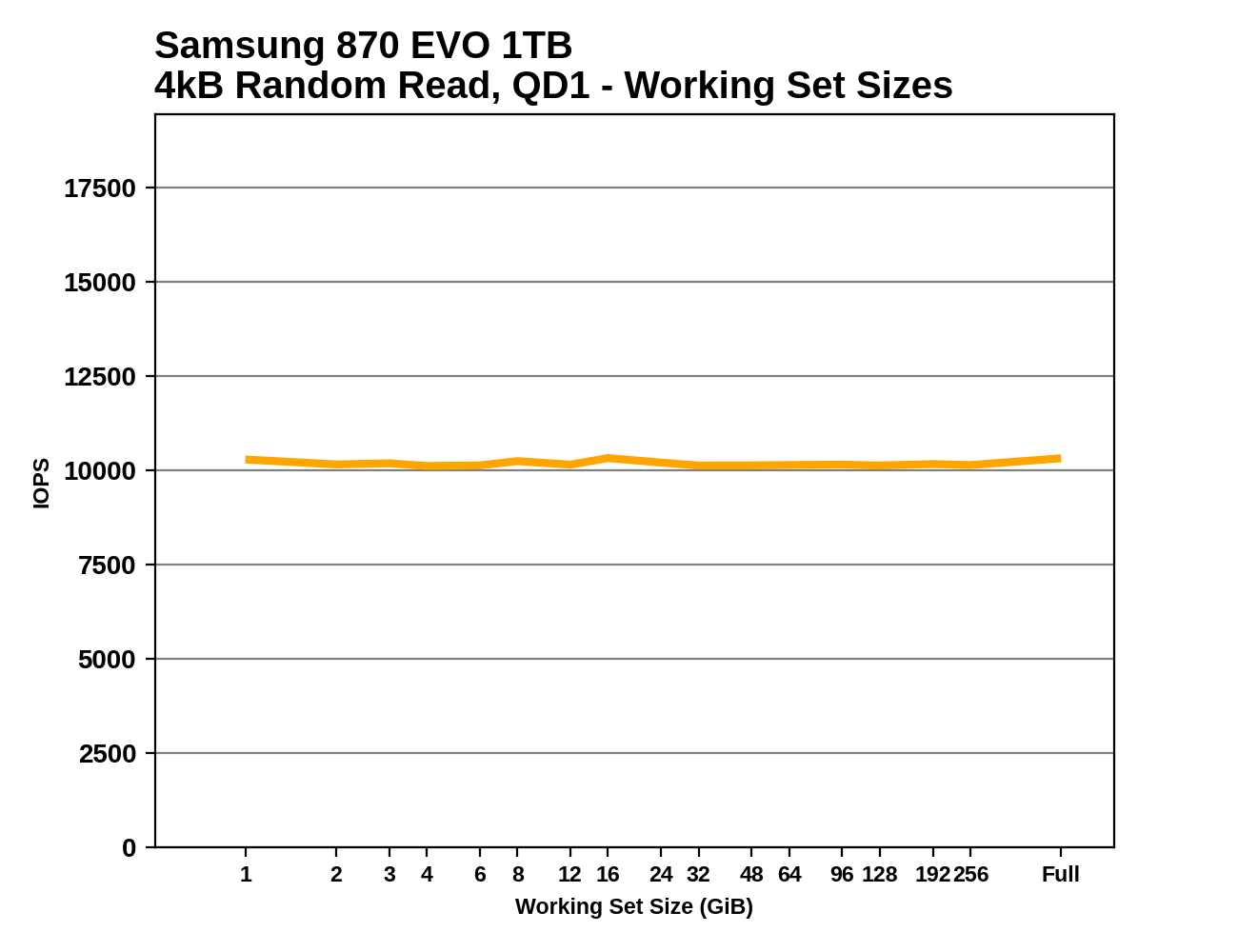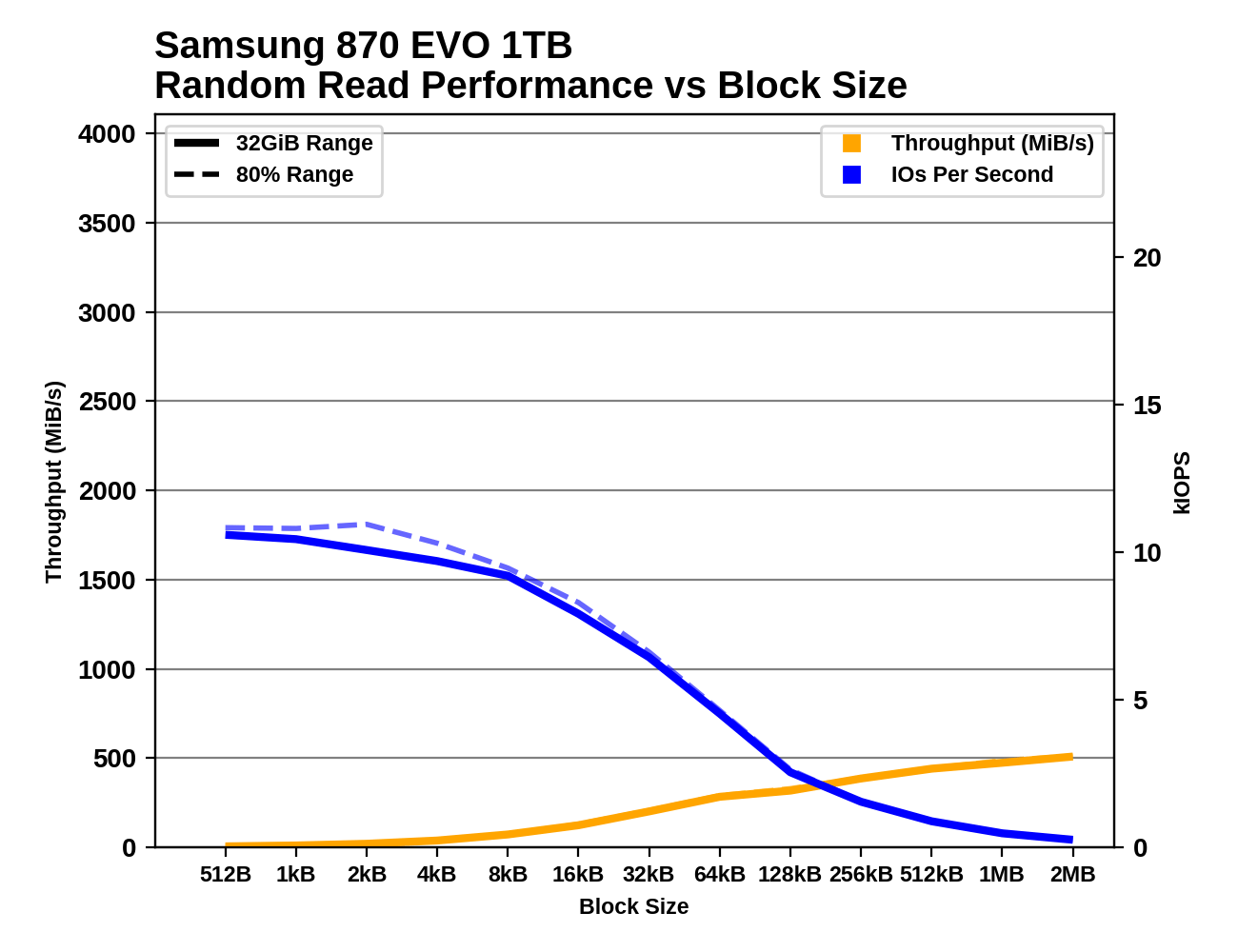The Samsung 870 EVO (1TB & 4TB) Review: Does the World Need Premium SATA SSDs?
by Billy Tallis on February 17, 2021 8:00 AM ESTAdvanced Synthetic Tests
Our benchmark suite includes a variety of tests that are less about replicating any real-world IO patterns, and more about exposing the inner workings of a drive with narrowly-focused tests. Many of these tests will show exaggerated differences between drives, and for the most part that should not be taken as a sign that one drive will be drastically faster for real-world usage. These tests are about satisfying curiosity, and are not good measures of overall drive performance. For more details, please see the overview of our 2021 Consumer SSD Benchmark Suite.
Whole-Drive Sequential Fill
 |
|||||||||
| Pass 1 | |||||||||
| Pass 2 | |||||||||
Some of our other tests have shown a few signs that the 870 EVO's write performance can drop when the SLC cache runs out, but this straightforward sequential write pass over the entire drive doesn't reveal any such behavior. The 870 EVO's sequential write performance is extremely consistent, even on the second write pass.
 |
|||||||||
| Average Throughput for last 16 GB | Overall Average Throughput | ||||||||
Due to the excellent performance consistency, the Samsung 870 EVOs edge out the other SATA drives with marginally higher average sequential write speeds. The entry-level NVMe drives end up much worse off than the mainstream SATA drives once their caches run out, but the more mainstream NVMe drive blows them all away.
Working Set Size
 |
|||||||||
As expected, the Samsung 870 EVO's random read performance shows basically no variation across a range of working set sizes, and that read performance is at least a little bit faster than any of the other SATA drives or the entry-level NVMe drives.
Performance vs Block Sizes
 |
|||||||||
| Random Read | |||||||||
| Random Write | |||||||||
| Sequential Read | |||||||||
| Sequential Write | |||||||||
There are no particular surprises in how the Samsung 870 EVO handles IOs of different block sizes. Unlike some drives, it has no trouble with sub-4kB IOs. It offers moderate improvements over the 860 EVO for mid-sized random reads (up to about 128kB). The one negative is that for writes we again see more inconsistency from the 870 EVO than the 860 EVO when testing an 80% full drive. The simple whole-drive sequential write test may not have been able to reveal any SLC caching troubles, but it does seem clear that the caching behavior has some performance regressions for more complicated workloads on a drive that's more well-used—though it's still unlikely to matter for any typical real-world consumer workload.










136 Comments
View All Comments
Gigaplex - Wednesday, February 17, 2021 - link
A half-decent UEFI implementation will enumerate the bootloaders (or fall back to the default /EFI/Boot/bootx64.efi path) if the drive isn't configured in the motherboard.Billy Tallis - Thursday, February 18, 2021 - link
Unfortunately, "half-decent" can't be taken for granted. The ASRock motherboard in the new SSD testbed won't look in the standard path for a bootloader, but it will happily boot any Windows bootloader it finds.Duncan Macdonald - Wednesday, February 17, 2021 - link
SATA may be declining but is far from dead - many motherboards (and laptops) only have one NVMe slot - adding a SATA drive is far easier than replacing the NVMe drive when it is the system drive. Also NVMe drives bigger than 4TB are rare and expensive so anyone needing large storage capacity (over 4TB) has a choice between SATA or expensive NVMe.Oxford Guy - Friday, February 19, 2021 - link
Some motherboard brands also don't know how to design a motherboard properly, like Gigabyte.Drives like the Inland Performance Plus (Phison) don't fit in boards like the Z390 UD.
Tomatotech - Wednesday, February 17, 2021 - link
These SATA circuit board PCBs are really tiny. I’ve sometimes wondered about removing the PCB from the drive and just plugging it direct into the motherboard SATA socket, no cable or drive case needed. This wouldn’t work out of the box as I think the motherboard port and the drive’s port are both the same gender.So this would need 1) a small gender changer intermediary, and 2) a way to get the power cable in there as well. Depending on the orientation of the motherboard SATA port, there might be space next to it for the power cable.
Tomatotech - Wednesday, February 17, 2021 - link
The advantages would be fewer cables and less space taken in small cases.Tomatotech - Wednesday, February 17, 2021 - link
If SATA drive manufacturers added a secondary power port at the top of the PCB (which they won’t do) and included a small cheap gender changer for the data port, this could become a feasible life extender for using SATA in small or crowded cases.Qasar - Wednesday, February 17, 2021 - link
" I’ve sometimes wondered about removing the PCB from the drive and just plugging it direct into the motherboard SATA socket,"is that what nvme physically is ? :-)
Gigaplex - Wednesday, February 17, 2021 - link
No, NVMe is a protocol. You're thinking of M.2, which doesn't have to use NVMe. There are actually many M.2 drives that use the SATA protocol.Gigaplex - Wednesday, February 17, 2021 - link
You've basically just described M.2 SATA mode.